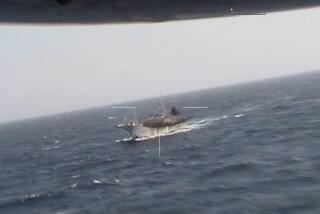San Diego Sportfishing Facing Problems : Fishing: Mexican government regulations could hurt businesses that specialize in tuna catches.
- Share via
San Diego’s sportfishing fleet, the largest and most sophisticated in the world, faces an uncertain future because of new regulations imposed by the Mexican government, and its operations could hinge on a meeting Monday between Mexican officials and a team headed by Bob Fletcher, president of the Sportfishing Assn. of California.
“We’re working very diligently to try to bring (to) the secretary or undersecretary of fisheries the concerns that we have for the regulations as we understand them,” Fletcher said. “We’ve had a very strong relationship for many years with Mexico and we certainly wouldn’t want to have that hurt, being forced into a situation where we couldn’t survive.”
Catch limits have been placed on all species sought by the fleet, but none is as restrictive as that placed on tuna, the boats’ main target. Although fishermen could previously catch as many as 10 tuna in one day, they are now limited to two a day and a total of six on trips lasting three days or longer.
San Diego’s long-range operations offer the world’s only opportunity to board a boat and travel directly to the Revillagigedo Islands off southwest Mexico, where 300-pound yellowfin tuna are found and fierce battles with 200-pounders occur regularly.
The San Diego overnight fleet, consisting of several dozen vessels, travels into Mexican waters regularly in search of tuna and other gamefish.
But if nothing is accomplished at the meeting in Mexico City, passenger loads on overnight and long-range fishing boats figure to drop significantly. Reservations are already being canceled.
“If you’re fishing for albacore (tuna) and you know that you only have two albacore you can catch, you’re not going to want to pay the kind of money that our boats have had to start charging,” said Fletcher, who added that on a good day a fisherman could be finished within a half-hour. The cost of an overnight fishing trip generally runs $100 or more.
Mexico’s fisheries secretary, Maria de Los Angeles Moreno Uriagas, drew praise from fishermen on both sides of the border when she announced what are reportedly the toughest regulations in the world for protecting a sportfishing resource from commercial exploitation.
Under the new regulations, commercial fishermen are prohibited from taking marlin, sailfish, swordfish, snook, dorado and roosterfish within 50 miles of the Mexican coast.
Boats must also obtain permission from the National Fisheries Institute to seek those species inside the 200-mile territorial limit, which will remain off-limits to foreign long-line fishermen.
But the new sportfishing regulations are worrisome, not only to the San Diego fleet but to the Ensenada operation. Both rely heavily on the American dollar--and the tuna.
Recreationally, fishermen are allowed one marlin, sailfish or swordfish; two dorado, roosterfish, tuna or sharks. A day’s combined take of all species cannot exceed eight fish.
On trips lasting more than three days, the maximum number of fish allowed cannot exceed the total permitted in three days of fishing. This means that on San Diego’s multi-day trips to the Revillagigedo Islands, popular among tuna fishermen for the last 20 years, anglers will be allowed no more than six tuna--at a cost of about $2,000.
There are fewer than a dozen boats capable of making the 1,500-mile journey to the tuna-rich islands, but between 35 and 40 excursions are made there each year. A typical passenger load is about 25 anglers, each of whom usually returns with several hundred pounds of tuna.
The entire fleet is being further curtailed by a regulation restricting the use of live bait “for the catch of the first two specimens on each day, after which only fresh or frozen dead bait can be used.”
Joe Chait, who owns and operates the Conquest, a sportfisher specializing in overnight excursions, said: “I really can’t see their reasoning with the tuna thing. The dorado thing, hey we can live with that; we don’t make a living on dorado.
“This was a real, real, real blow. Just when you think you’re going to finally skate by a season with no problems. . . everything’s looking on track, and then they slip something like this on us.”
San Diego’s sportfishing fleet of about 70 boats averages between 400 and 500 tons of tuna each year, a take Fletcher says is “pretty small in the scheme of things.” He points out that one commercial boat is capable of matching that on a single haul.
But some Mexican hotel owners believe that San Diego’s vastly superior boats are taking away business that might otherwise be theirs.
“These boats from San Diego come and fish into the islands and then they get back and they have 30-40 tons of fish,” said Luis Bulnes, owner of Cabo San Lucas’ Solmar Hotel. “That is commercial, that is not sportfishing.”
Tuna stocks, however, do not appear to be in any trouble, and in fact, catches have remained fairly steady in the last few years. This has been one of the better seasons at the Revillagigedo Islands, according to Bill Poole, who pioneered the long-range movement in the early 1970s.
“The yellowfin resource is in pretty good shape,” said Dr. Bill Bayliff, a senior scientist with the Inter-American Tropical Tuna Commission. “It’s neither overfished nor underfished--it’s pretty close to being fished at the optimum rate.”
California Department of Fish and Game records show that in 1988, recreational fishermen caught 22,845 tuna. In 1989, there were 71,825 taken. In 1990, the total was 53,400. San Diego-based boats are required to log catches with the DFG, even fish taken from Mexican waters.
Still, Bulnes, one of Cabo San Lucas’ more influential citizens, said the area’s rapid growth and reliance on the tourist-fisherman have led to steps he calls necessary to assure their survival. The Cabo San Lucas sportfishing fleet has grown from fewer than two dozen boats in the early 1970s to about 150.
“This was a very nice fishing village, and now there is lots of action all over,” Bulnes said. “And we have to pay the price of progress. We have to protect.”
However, the new regulations aren’t likely to affect Mexican hotel owners or their sportfishing operations.
On a typical day fishing aboard a cruiser or panga out of Cabo San Lucas, Mazatlan or Acapulco, a fisherman might catch a marlin or two; will probably catch a few dorado, and more than likely will remain within the new limits on tuna and roosterfish.
Visitors to such locations are usually on vacation and probably won’t complain if told they will not be able to take home massive quantities of fish.
The regulation that cut or dead bait must be used after two fish are caught with live bait wouldn’t affect fishermen aboard Mexican boats. There are no bait boats or receivers from which to readily supply the Mexican fleet, anyway. Most fishermen on those boats use artificial lures or a few live mackerel or sardines caught in a small throw net.
“Based on my own review of the regulations,” Fletcher said, “it appears that they were drafted by someone who was familiar with the Cabo San Lucas-Mazatlan-Acapulco kind of hotel boat operation where the passengers never keep the fish; they just go out fishing, come back in, give the fish to the boat, maybe have their picture taken.”
Fletcher added that Mexico stands to lose a fair amount of American dollars should there be a substantial cutback of U.S. boats traveling south to fish in Mexican waters.
Mexican fishing permits have increased from $1.50 a person three years ago to $4.75; boat license fees have increased from $3 a ton per month in 1988 to $8.82. Most boats entering Mexican waters weigh between 65 and 100 tons.
Excursion permits, which replace fishing permits on trips of five days or more, are up from $8 in 1988 to $33.45 in 1991.
The San Diego fleet in 1989 paid more than $400,000 in fees and permits to Mexico to fish in its waters. In 1990, it paid more than $700,000. This year, costs are expected to surpass $1 million.
The Royal Polaris itself accounted for about $10,000 in fees to the Mexican government last year.
“Not only are they going to lose the revenue,” Fletcher said, “but they’re going to lose a whole lot of people who have been very well disposed towards Mexico over the years, because they’ve had an opportunity to go into Mexican waters to catch fish.”
More to Read
Sign up for The Wild
We’ll help you find the best places to hike, bike and run, as well as the perfect silent spots for meditation and yoga.
You may occasionally receive promotional content from the Los Angeles Times.






